


 |
 |
 |
Rita Kop and Hélène Fournier
National Research Council of Canada
John Sui Fai Mak
Australia
This paper examines how emergent technologies could influence the design of learning environments. It will pay particular attention to the roles of educators and learners in creating networked learning experiences on massive open online courses (MOOCs). The research shows that it is possible to move from a pedagogy of abundance to a pedagogy that supports human beings in their learning through the active creation of resources and learning places by both learners and course facilitators. This pedagogy is based on the building of connections, collaborations, and the exchange of resources between people, the building of a community of learners, and the harnessing of information flows on networks. This resonates with the notion of emergent learning as learning in which actors and system co-evolve within a MOOC and where the level of presence of actors on the MOOC influences learning outcomes.
Keywords: Connectivism; networked learning; media affordances; learner autonomy; presence; roles; educator
The emergence of new technologies and their effect on the volume and nature of information on the Web are influencing the context of education and learning (Bouchard, 2011). The structure of the learning environment, the place and presence of learners and educators within institutional boundaries, and the nature of knowing and learning are all challenged by the fast pace of technological change. Weller (2011) highlights the changes involved in moving from a learning environment of scarcity, based around the lecture model and books, to a web-based environment of abundance and examines different models of pedagogy to deal with these changes. Not so long ago, educators would find resources and information and would distribute these to learners in their care, perhaps by displaying them in a learning management system (LMS). They would try to help learners in the development of conceptual frameworks by direct communication and social interaction within a classroom community, be it virtual or face-to-face. Emergent technologies provide different models and structures to support learning. They disrupt the notion that learning should be controlled by educators and educational institutions as information and “knowledgeable others” are readily available on online networks through the press of a button for anyone interested in expanding his or her horizon.
Of course this puts the responsibility for information gathering, the validation of resources, and the learning process in the hands of learners themselves, and one should question if all adult learners are capable of taking on this responsibility. The Web no longer consists solely of hyperlinked text pages, but has evolved into a complicated mesh of interlinked sites, consisting of human communication, writing, and digital artifacts. To manage this vast network of resources effectively requires learners to be autonomous in their learning and to have advanced analytic and synthesis skills to distill relevant information from the “noisy” network. Moreover, a high level of competency and interest in using a vast array of tools is required to do so effectively. Being able to distinguish the wheat from the chaff of information clearly becomes important as educators might no longer be available. Some argue that people’s information behaviour should change from receiving information from a few “super nodes” on networks to moving into the information stream themselves and pulling just-in-time information off the networks, perhaps by receiving validation from other users (Boyd, 2010). The challenge includes not only the validation of the information but also the generation of ideas and thoughts that the organized institutional social setting of the past might readily provide, and which is much harder to achieve on a network with much weaker ties. We would argue that one of the major challenges is to create a pedagogy that supports human beings in their learning where the social connections people make on the network provide their learning support.
This paper will examine how emergent technologies might influence the design of the learning environment and in particular the roles of educators and learners in creating learning experiences on online networked learning environments. It will do this through the lens of a case study of massive open online courses.
Barnett (2002) highlighted that we now live in a world characterized by “super-complexity,” uncertainty, and change: “Work, communication, identity, self, knowing, and even life: the meaning of fundamental concepts are no longer clear in a world of change” (p. 9). Barnett (2002) had his own interpretations of knowledge in relation to uncertainty and change. He would like to see curricula and pedagogy move away from knowledge and skills to be a “pedagogy for human beings.” He discussed a form of knowledge that would involve learners thinking about and confronting themselves with the uncertainties and dilemmas in their own lives. Learning is at the heart of personal change and transformation, and the learner needs to take risks and deal with changing situations in his or her environment. Folke (2010) emphasized the need for resilience, so people will anticipate change then influence developments to achieve societal and personal goals. At the heart of sustainable change is developing and helping people to build up an “inner resilience” that guards them from experiencing every change that comes their way as disruptive. Instead, this resilience ensures that they learn to cope with these changes more as part of their continuous “agile” development and learning (Cashman, 2009), recognizing patterns in one situation and making sense of them and applying them in another.
However, this is easier said than done, and some questions spring to mind when relating resilience and change to emergent technology where the use of new technologies and the application of the information they produce is part of the continuous process of lifelong and lifewide learning. For instance, how to help and support fellow learners in dealing with the new realities of an abundance of information? How to make the most effective use of the tools? How best to position oneself in the continuous stream of information and communication and learn from others? What would motivate people to regulate their learning? In short, what would be the important factors in the design of a learning environment to support learner self-direction on online networks, and what should be the place and role of the educator?
Shedroff (2009) argued that in current design practice, the main focus should be on creating environments that encourage relationships with individuals, experiences that connect on an emotional and value level. It is not enough to introduce some tools to create an effective working environment; one should also design for the building of connections, collaborations between resources and people. In a learning environment characterized by change, the tools and applications it recommends to learners and the connections it facilitates to other learners and knowledgeable others are vitally important to create learning experiences. The learning flow might be visualized as done by Kop (2010) in relation to a personal learning environment (PLE) and shown in Figure 1.
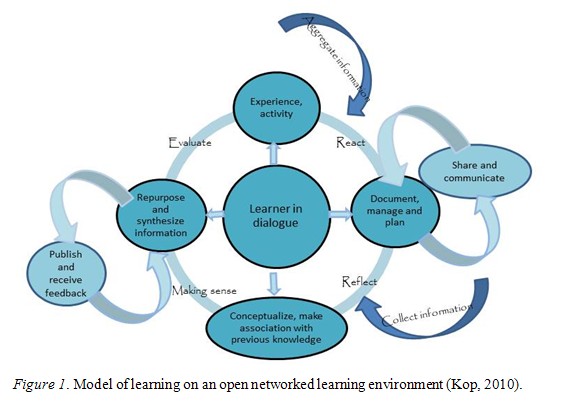
Kop based the model on the Kolb learning cycle (Kolb, 1984): The learner has an experience or a thought and would like to find out more or might want to get involved in an activity that requires exploration. He or she then aggregates information, plans the learning activity, and might call on others to discuss the generated ideas and ask for assistance. The learner would quite likely be engaged in a thinking process where links are made with other knowledge. This might in turn lead to a repurposing of the information and resources, for instance by using them to produce something or publish an artifact that might receive comments and feedback from others then leading to an evaluation of the learning process and the development of a further learning cycle.
In support of the learning cycle model, Kop (2011) puts a high value on the creation of a “place” where learners might feel comfortable, where there is a certain level of trust between participants in that environment—a community. She argues that the development of a place or community would be reinforced by a level of “presence” of the participants. Research by Garrison and Anderson (2003) and Jézégou (2010) emphasized the importance of presence in online learning environments. Presence is mostly defined in the literature as the “illusion of non-mediation” (Lombard & Ditton, 1997). In other words, there is a high level of presence when a participant in an online activity experiences the activity as if it were taking place in real life, without the mediation of the computer. Garrison and Anderson (2003), in their research on communities of inquiry, identified three interlinked forms of presence that heighten the engagement of online learners: social, cognitive, and teaching presence. Social presence is characterized by affective engagement, open communication, and a high level of personal address by and between participants. Wenger, Trayner, and de Laat (2011, p.10) highlight that “the social fabric of learning” is supported in important ways through collaboration both in a “community” and on the “network.” Added value to learning comes not only from the development of trust and confidence in a community, but also from social engagement on networks in producing and re-using discourse and artifacts. Cognitive presence is characterized by a triggering event, an exploration of ideas and points of view, a consensus on the points of view (reached by communication with and feedback from others), and then a testing and discussion of the found solution. Teaching presence involves the design and organization of the course, the facilitation of the course, and direct instruction.
There is a relation between these forms of presence (Annand, 2011) if we connect Garrison and Anderson’s findings related to presence to the model of learning on an open networked environment in Figure 1. It becomes clear that social presence and cognitive presence could easily form part of the learning experience of a learner in such an environment through the formation and engagement both in communities and, more loosely, on networks. Teaching presence is much harder to facilitate as learners do not necessarily have contact with the educator, but it is the teaching presence that heightens cognitive presence (Annand, 2011). People learning on open networks could have access to knowledgeable others to support them, might find videos to inspire their thought processes, and could also self-regulate and organize their learning. This would, however, require a high level of self-direction by the learner. Researchers of learning on online networks can see new roles emerging for educators, such as those of curator, learner, facilitator, supporter of “repurposing” and “remixing” of information, coach, moderator, provider of technical support, lecturer, and “sharer” of resources (Siemens, 2008; Downes, 2010). In this context, the MOOC acts as an environment in which new forms of distribution, storage, archiving, and retrieval offer the potential for the development of shared knowledge and forms of distributed cognition. Characteristics of learning based on a conversational framework emphasize tutor–student dialogue and actions based on dialogue and reflection (Laurillard, 1993). In this sense, the MOOC allows a new model of learning based on adaptive responses to both discursive and active feedback from facilitators and participants, with the potential for engagement in a continual flow of dialogue and exchange and for reflective action on the part of the learner.
In the case study that follows, these are the roles that were taken on by facilitators on MOOCs. We will report on research in such learning environments and highlight how participants experienced the support provided and how they took on supporting roles themselves to heighten levels of presence. We will also provide some recommendations based on learner and facilitator experiences.
A massive open online course (MOOC) engages networked learning methods but not within the typical structure of a traditional course. More like an online event, MOOCs invite open online participation around a topic of interest and a schedule or agenda, facilitated by people with a reputation or expertise in the topic of discussion, relying on successful formations of learning networks to assist people studying the topics. In this context, we will focus on MOOCs as an opportunity to conduct research on networked learning in an open environment.
This next section presents findings from two MOOCs, offered as a joint venture between the National Research Council of Canada’s (NRC) Institute for Information Technology and the Technology Enhanced Knowledge Research Institute (TEKRI) at Athabasca University. Findings will be drawn from the Personal Learning Environments Networks and Knowledge course (PLENK2010) and the Connectivism and Connective Knowledge course (CCK11), consisting of a vast amount of data as part of networked learning in an open environment. Two of the facilitators in the MOOCs were the founders of Connectivism, earmarked as the latest theory of learning and knowledge (Siemens & Downes, 2008, 2009). The facilitators, highly visible and knowledgeable in the field of study, were active on the course, found resources and speakers, and participated in all aspects of the course. MOOCs in this context did not consist of a body of content and were not conducted in a single place or environment. They were distributed across the Web. This type of learning event is called a connectivist course and was based on four major types of activity: 1) Aggregation – access to a wide variety of resources to read, watch, or play, along with a newsletter called The Daily, which highlighted some of this content; 2) Remixing – after reading, watching, or listening to some content, it was possible to keep track of that somewhere (i.e., by creating a blog, setting up an account with Delicious and creating a new entry, taking part in a Moodle discussion, or using any service on the Internet); 3) Repurposing – participants were encouraged to create something of their own; in these MOOCs, the facilitators suggested and described tools that participants could use to create their own content, and it was envisaged that with practice, participants would become accomplished creators and critics of ideas and knowledge; and 4) Feed Forward – participants were encouraged to share their work with other people in the course and with the world at large.
The courses included several tools. Elluminate is an online synchronous collaboration system for hosting live weekly sessions. Archived recordings were accessed 10 times more than participation in the live sessions. PLENK2010 included a course Moodle (an LMS), a platform that was much too centralized, according to one of the course facilitators (Siemens, 2011). One of the significant changes in the latest MOOC offering, namely CCK11, was the move away from the centralized Moodle environment toward aggregating and collating artifacts or meaningful resources into a single dashboard, viewed by some to be a more personalized medium. This was accomplished with the gRSShopper application (Downes, 2008). gRSShopper, an RSS aggregator, and the Daily newsletter derived from it were used to overcome an identified limitation of a more rigid structure for forum discussions in the Moodle environment. gRSShopper allows a networked conversation to emerge from the personal learning spaces of individual learners through a connect-and-collaborate dynamic that facilitators found to be well suited to the just-in-time collection of information prevalent in MOOCs. The support offered through gRSShopper was significant, as evidenced by a participant who commented,
It helps learners to map the terrain of the conversation without telling them where to go. Aggregation of independent points of view is one of the key mechanisms to cultivating and harnessing the wisdom of crowds, and gRSShopper does that.
When a connectivist course is working well, one can see a great cycle of content and creativity that begins to feed on itself with people in the course reading, collecting, creating, and sharing. Participants were encouraged to create their own spaces. The main driver was to wrap the social elements around the course content, such as the readings, resources, and Elluminate sessions (Siemens, 2011).
Various approaches to researching MOOCs have been adopted across course offerings, including surveys of participants, tracking of activities, and artifacts produced with the course tag identifier. A mixed-methods approach and a variety of research techniques and analysis tools were used to capture the diverse activities and the learning experiences of participants on MOOCs. Surveys were carried out to capture information on learning experiences during the PLENK MOOC, more specifically an End of Course survey (N = 62), an Active Producers survey (N = 31), and a Lurkers survey (N = 74), as well as a Research into the Design, Delivery, and Learning in MOOC PLENK2010 survey (N = 55).
In addition, qualitative methods in the form of virtual ethnography have been used. A researcher was an observer during the course, collecting qualitative data through the observation of activities and engagement and also carrying out a focus group in the final week of the course to gain a deeper understanding of particular issues related to the active participation of learners. Because vast amounts of discursive data were generated and collected, computational tools have been used to represent large networks of activity in the PLENK, to identify themes in the data, and to analyse and interpret the qualitative research data. For the data analysis on PLENK2010, the Moodle data-mining functionality was used and provided participant details, their level of use and access of resources, information on course activities, and discussions taking place in the course forums. The gRSShopper aggregator statistics functionality provided details on course-related use of blogs and micro-blogging tools such as Twitter.
Demographic data from PLENK2010 revealed that the professional background of participants included education, research and design, and development of learning opportunities and environments. Individuals participating in PLENK2010 had comparable profiles to those on previous and subsequent MOOCs and were employed as teachers, researchers, managers, mentors, engineers, facilitators, trainers, and university professors. Chart 1 shows the distribution for age of PLENK2010 participants, and Figure 2 shows a Google Map, instigated by one of the PLENK participants, representing participants’ places of residence.
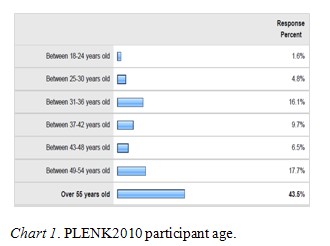
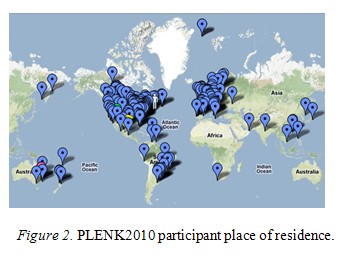
The purpose of the PLENK2010 course was to clarify and substantiate the concepts of personal learning environments and networks. Course facilitators and participants would analyze the research literature and evaluate it against their own experience with the intent of developing a comprehensive understanding of personal learning environments and networks. The purpose of the CCK11 course was to explore the concepts of connectivism and connective knowledge and to explore their application as a framework for theories of teaching and learning. Neither course included formal assessments of learning outcomes as the learning objectives for each learner on the MOOCs was different, dependent on his or her context. In general, people participated on the MOOCs to learn more about certain topics and technologies and at the same time build a personal network.
Typically, the number of registered participants on MOOCs is high, but the nature of participation in course activities is varied and changes over time. When PLENK2010 started, 846 had registered, and that number steadily increased to 1,641 at the end of the course. In addition, global participation and multiple time zones influenced who participated actively in the MOOCs, especially during the live Elluminate sessions. A high number of blog posts (949) and an even higher number of Twitter contributions (3,459) were generated in relation to the PLENK2010 course. The course identifier, #PLENK2010, facilitated the easy aggregation of blog posts, Delicious links, and Twitter messages produced by participants, which highlighted a number of resources and links back to participants’ blogs and discussion forums, thus connecting different areas of the course.
Although the number of course registrations was high, an examination of contributions across weeks (i.e., Moodle discussions, blogs, Twitter posts marked with the #PLENK2010 course tag, and participation in live Elluminate sessions) suggested that about 40–60 individuals on average contributed actively to the course on a regular basis by producing blog and discussion posts, while others’ visible participation rate was much lower, indicating a consuming behaviour. PLENK2010 surveys indicated that active participation through the production of digital artifacts and interaction with others was conducive to positive learning outcomes as it helped participants to reflect and involved them in a creative process that stimulated their cognitive processes.
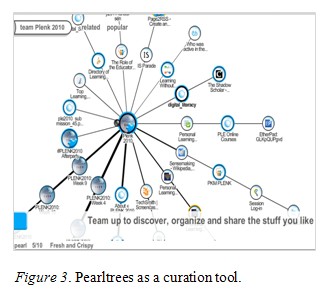
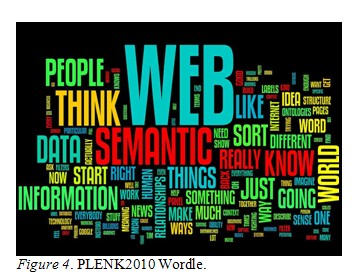
Some people with previous experience in learning in a MOOC were very active and involved in the course. For instance, one participant’s Google Map, shown in Figure 2, has received 22,267 views so far, and her blog has been read in 68 countries. Another participant created his own RSS aggregator and used Pearltrees both as a curation tool to collect information and resources related to the course and as an exploratory learning object and social network builder (Figure 3). Some learners used Wordle to “skim-read” papers and visualize the content of a paper (Figure 4), while another created an animation video about PLENK2010, dubbed “The Most Awesome Course on Planet Earth.” PLENK groups were created in Second Life and Facebook to discuss topics and participate in the course from other vantage points.
Analytics tools were used to visualize complex networks between people. The social analysis tool SNAPP was used to produce online network visualizations of discussions, such as interactions between participants in the course Moodle forums. Figure 5 presents a complex network of interactions between participants in one Moodle forum discussion in which the facilitator acted as a key instigator of activity. This visualization shows the presence of the facilitator and of a number of active participants on the network who played an important role as well. Figure 6 illustrates the complexity in making sense of all the interactions on a network, for 1 out of 10 weeks of discussion in the Moodle forum.
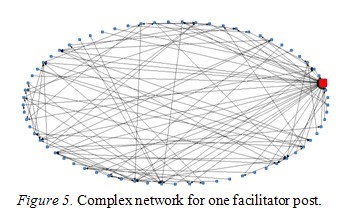
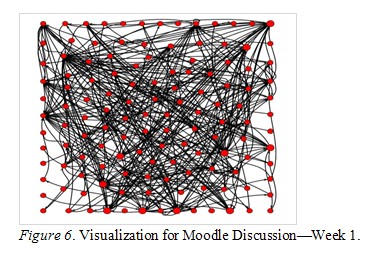
Connecting on the network was important to support the active participation of learners. One PLENK participant expressed the following:
To be a connectivist is to choose your network, any network, and then use whatever personal tech tools are out there to take your node (also known as your brain) and absorb the information you are seeking in order to create, solve, perform in both virtual reality and location-based reality.
Another learner highlighted in her blog what activity she perceived to be required in a connectivist course: “Networks are then the structures through which knowledge is created, shared, and improved during a MOOC, particularly by participants.”
MOOC participants left the environment structured by facilitators and congregated elsewhere by using social media. A Facebook (FB) group was set up by the participants of some MOOCs (CCK11, PLENK2010) and was run by the participants as a case of self-organised learning. Much of the participants’ educational use of FB was based around topics of interest, postings, comments related to blog posts or artifacts, post-hoc critiquing of learning experiences and events, and instances of moral support with regards to assessment or learning. A few credit-bearing participants of CCK11 used FB for posting links of their assignments for comments.
However, only a limited number of participants joined the FB groups (8.2% of 1641 PLENK2010 participants and less than 18% of 700+ CCK11 participants), and only a small proportion of FB group members were active at any one time during the course. Subtle concerns and issues arose. Some participants did not join the PLENK or CCK11 FB group for privacy and personal security reasons. Others who joined the FB groups remained as peripheral participants for the duration of the course. Participants also highlighted the need for a sense of trust and feeling comfortable and confident to be able to participate, as well as a sense of presence and community. Some learners preferred the Moodle forum over FB as they expressed that they were able to learn more about the background, ideas, and beliefs of other participants than in FB. The CCK11 MOOC did not have a Moodle environment, and an excerpt from a blog post of a participant of CCK11 highlights some relevant issues:
The relative “character” anonymity of participants in the CCK11 as compared with the PLENK2010 cohort was an obstacle. The PLENK (Moodle) forum provided an easily navigated discussion interface. From the contributions on a wide variety of topics, I learnt a lot about the passions, the character, the beliefs of the participants. We were fellow learners, not just network nodes, and I would imagine a certain degree of trust was established between many of the participants. Facebook, the seeming preferred CCK11 gathering place, does not provide the same level of personal connection for me, so I am not currently feeling particularly nodish.
This highlights the need of participants for social presence, but in a self-determined way. Learning under MOOCs is an interactive experience best achieved in a climate of relatedness, care, mutual respect, and support. Such care is offered, not imposed, and respects humans’ need for autonomy, self-determination, and challenge, as well as for security (Arnold, 2005, p. 18). PLENK2010 and CCK11 participants made use of Twitter, a Web 2.0 micro-blogging tool that enhanced social presence by providing a mechanism for just-in-time social interactions. It provided authentic opportunities to connect and be perceived as “real” in ways that traditional LMS-contained tools could not. There were participants who valued Twitter and found it the best tool for learning, connecting, and interacting with PLENKers. A further survey in CCK11 revealed that participants ranked Twitter as the most important tool for interaction and communication in the MOOC. The feedback from some participants, however, suggests that Twitter was still too new and foreign to them in PLENK2010, and a significant number of participants were hesitant to use it in public:
Twitter still seems too much another big distraction construction site for me yet . . . I merely use it to either retweet great tweets I stumbled upon, or to tweet valuable links via shareaholic, so “from outside,” but I often follow #streams for events or topics, sometimes multiple, via tweet tabs though.
Observations of the use of Twitter, however, showed that it supported coherence and connections between different tools during PLENK2010 and CCK11, including back channels to synchronous sessions, updates of news and events, and links to recordings.
There seemed to be a gender difference in the perception of the value of community building and the organization of communication. The research highlighted a difference between men and women in terms of their communication styles and preferences. Women tended to look for similarities or commonalities (i.e., in issues of language) that could become a source of bonding. In contrast, some men had a tendency to practice one-upmanship, in the sense of trying to keep one step ahead of other participants as competitors. Men were more task-oriented in their use of language, while women put more emphasis on socioemotional dimensions. For example, in one course activity that was taken up by PLENK participants, the female participant tended to play more of an assistant/supportive role and responded in an inclusive way, while her male counterpart tended to delegate tasks.
It is clear, however, that there were deficiencies in the support structures of the MOOCs. The small number of facilitators (only four for PLENK2010 against 1,641 participants and two for CCK11 against 700+ participants) available to support learners in the MOOCs raised concerns about their level of interaction, participation, and engagement: “Too little participation and interaction by the facilitators. Be sure to provide a higher level of participation by facilitators.” If teacher presence supports cognitive presence, then support by facilitators and experienced MOOC participants is clearly important to enhance the learning process. The open nature of MOOCs means a lack of advance knowledge about participant numbers and a difficulty in projecting facilitator requirements at the start of a MOOC.
Some participants were expecting directions from the facilitators, while others found the course intimidating, overwhelming, and lacking in excitement as it progressed: “The course was essentially without directions. […] The scale of things is always something that I find both fascinatingly cool and at times a bit intimidating and overwhelming.”
The lack of a coherent and centralized structure and a lack of summary around learning in the MOOCs also presented challenges for some participants, in particular the novice learners. The choice of tools allowed learner autonomy, but was at the same time seen as a reason for a fragmentation of the conversation: “too much freedom in choice of tools unnecessarily fragments the conversation unless other tools are used to recombine the process.” gRSShopper was used as a central tool for aggregation in CCK11 but was still not perceived as drawing resources enough into a meaningful conversation.
The difficulties in evaluating the course and its objectives were highlighted by some participants as they found it hard to assess learning outcomes. The objectives were not set by facilitators, but were personal goals set by individual participants, so they were different for each person. Other barriers to learning were time zone differences, language differences, difficulties in connecting with others in different spaces, lack of skills in the use of tools, difficulties in making connections with facilitators and/or learners, and power relations. Furthermore, a high number of participants mentioned personal reasons, such as lack of time to participate, as explanations for why they took on more of a consuming role in the course rather than an active, participative one.
Some support structures were perceived as positive by participants, who indicated that course resources such as The Daily newsletter, the Moodle, and the wiki (for PLENK2010), and gRSShopper (for CCK11) were enough to feel comfortable in the course (Fournier, Kop, & Sitlia, 2011). Some new MOOC participants enjoyed the open structure: “This was my first course of this kind, and I enjoyed the open structure. It would not be suitable for just any content, but for this subject it seemed well suited.”
Some experienced MOOC participants realized that the learning environment could be self-constructed. They also found improvements in the organization of content and instructions over past MOOCs: “Last year I would have said seeming lack of structure was a barrier. With experience the structure appears or can be self-constructed.”
It was clear that experience with this type of learning increases chances of success and the level of activity and participation. Having a network of learners and a community to draw support from was considered important to enhance personal autonomy, as was revealed by one participant:
While chaotic course structure was a barrier, it was also a benefit. It was difficult to keep everything about the course organized in my head. I later realized that I didn’t need to worry about it so much. It just happened and the outcome for me was increased knowledge and a network of learners that I could draw from.
Participants also highlighted positive aspects related to support received. Respondents to the PLENK2010 survey were appreciative of how the facilitators led without directing and also of the work and engagement provided by the facilitators. Thus, teaching presence, especially exemplified through course design and the type of facilitation, turned out to have a powerful effect on student perceptions of support, inclusiveness, and overall satisfaction with the course. The participants valued greatly the autonomy on connections and participation in networks: “We were given free choice and allowed autonomy about our ways to connect and participate in the network. I greatly value this approach to learning and working together.”
Many participants realized the importance of connections with other learners and of relationship building to advance learning. However, in a MOOC, they found these things extremely hard. Some learners did manage to be connected with a few others and interact in small groups: “I still feel like I struggle to make collaborative relationships online and asynchronously. It is as much a need to improve my relationship-building skills and perfect my organization abilities with existing tools.”
Connections with people for learning could then be experienced through the support, help, and inclusion in groups.
I was pleasantly surprised that others took my questions seriously and were willing to give me a hand. Everyone seems to be very generous of their time and knowledge. Then I was given invitation to join groups. That was very good.
However, there were some participants who didn’t feel confident or secure when connecting in blogs or forums in PLENK2010. This impacted their level of participation and engagement in the course, as exemplified by this comment:
I was very afraid to step out into the world and blog. I learned that my recent overflow prohibits me to write good posts, but I stepped out after all. Due to the quality of my posts I only tried to connect them slightly, but this worked very good and I am grateful for the chance to explore and the people I met.
Some participants of PLENK2010 and CCK11 were also concerned about some anonymous contributions and incidents relating to personal criticisms of facilitators and participants, possibly highlighting cultural or gender differences in perceptions of acceptable power relations on the course network.
This research showed the importance of making connections between learners and fellow-learners and between learners and facilitators. Meaningful learning occurs if social and teaching presence forms the basis of design, facilitation, and direction of cognitive processes for the realization of personally meaningful and educationally worthwhile learning outcomes.
Different learning objectives and different life contexts of learners in an open course lead to different levels of participation in learning activities and subsequently to different learning outcomes. The current research pointed to a maturing of e-learning users; the more experience in networked learning and through MOOCs, the higher the level of participation. People produced artifacts and created learning networks when confident with the technology and with the topic under discussion, while among new MOOCers there was a higher level of consumption of resources created by others. These results confirm research by Mak, Williams, and Mackness (2010) showing an emerging and growing practice across learners to develop those new affordances in innovative and nuanced ways. The challenge in a MOOC is whether the levels of support by facilitators and other learners and the affordances of a complex emerging learning environment will align and aid participants in such sense-making, and whether the openness, diversity, and interactivity of MOOCs aids participants on their personalized learning journey.
The type of support structure that would engage learners in critical learning on an open network should be based on the creation of a place or community where people feel comfortable, trusted, and valued, and where people can access and interact with resources and each other. The new roles that the teacher as facilitator needs to adopt in networked learning environments include aggregating, curating, amplifying, modelling, and persistently being present in coaching or mentoring. The facilitator also needs to be dynamic and change throughout the course. Scaling up to the majority in networked learning requires facilitators to adopt a multifaceted role so as to guide or influence the learners and communities to get involved and embrace social media practices. The significant role of the knowledgeable others or other learners is to share part or all of the roles of the facilitator and support other learners by taking an active, participative, and critical role in connectivist learning by communicating, sharing, cooperating, and collaborating with and providing feedback to each other in the communities or networks.
Novices can best be supported through a series of activities that are structured on connectivist learning principles with a goal to enhance autonomy and the building of personal learning networks. Such scaffolding is necessary to build confidence and self-efficacy and to ensure novices will feel confident and competent in using technologies and are supported throughout the course.
Future MOOCs could be based on the learner-in-dialogue model as shown in Figure 1 and on the co-creation of the MOOC environment as a “place” with activities that would reinforce the orientation for learners, such as the development and practice of peer facilitation, mentoring, and coaching, the development of a personal network and digital literacies, and the building and development of personal and social networks and communities. These would encourage learner-centred approaches and match the affordances of new and emergent media. These would encourage new, active, and participatory forms of communication and collaboration and would also ensure that space is made available for substantial, self-motivated, self-organized, emergent learning to occur.
A challenge associated with the educational use of the Web, social networking, and media, based on the MOOC distributed learning model, is that the open, emergent, chaotic nature of online interaction might conflict with the rigidly organized social structure of formal education, which involves prescriptive learning, standardized goals and curricula, fixed schedules, age-based grouping, classroom-based organization, and examinations. This formal view of education is problematic for professional learning and highlights a tension between learning in everyday life facilitated by emerging technologies and the philosophical stance and the pedagogies adopted by universities. A change in the thinking, philosophy, design, and pedagogies of institution-based online courses may be necessary if the affordances of emerging technologies are embraced and adopted within formal educational institutions. Considerable efforts will also be required to ensure an effective balance between openness and constraints when an online institutional course is fused with social networks. The adoption of MOOCs in formal education institutions is challenging, though it opens up new opportunities to experience the co-creation of networks within communities and new and participatory forms of communication and collaboration for both learners and educators.
Further research will be conducted to explore the role educators and learners should play in adding value to the learning experience through the matching of informal and formal learning by the creation of a symbiosis between the educational social community and the more open collaboration on online networks.
Annand, D. (2011). Social presence within the community of inquiry framework. The International Review of Research in Open and Distance Learning, 12(5), 40–56. Retrieved from http://www.irrodl.org/index.php/irrodl/article/view/924
Arnold, R. (2005). Empathic intelligence: Teaching, learning, relating. Sydney, AU: University of New South Wales Press, Ltd.
Barnett, R. (2002). Learning to work and working to learn. In F. Reeve et al. (Eds.), Supporting lifelong learning, Vol. 2: Organizing learning (pp. 7–20). London, UK: RoutledgeFalmer.
Bouchard, P. (2011). Network promises and their implications. In The impact of social networks on teaching and learning [Online monograph]. Revista de Universidad y Sociedad del Conocimiento (RUSC), 8(1), 288–302. Retrieved from http://rusc.uoc.edu/ojs/index.php/rusc/article/viewFile/v8n1-bouchard/v8n1-bouchard-eng
Boyd, D. (2010). Streams of content, limited attention: The flow of information through social media. EDUCAUSE Review, 45(5), 26–36.
Cashman, K. (2009). Leading with agility. Change This, 54. Retrieved from http://209.131.79.202/manifesto/54.03.LeadingAgility/pdf/54.03.LeadingAgility.pdf
Downes, S. (2008, May 23). gRRShopper. Message posted to http://www.downes.ca/. Retrieved April 11, 2011, from http://www.downes.ca/cgi-bin/page.cgi?post=44682
Downes, S. (2010, May 12). The role of the educator. Huffington Post Education. Message posted to http://www.huffingtonpost.com/education/. Retrieved from http://www.huffingtonpost.com/stephen-downes/the-role-of-the-educator_b_790937.html
Folke, C. (2010, December 13). How much disturbance can a system withstand? With roots in ecology and complexity science, resilience theory can turn crises into catalysts for innovation. Seed Magazine. Retrieved from http://seedmagazine.com/content/article/on_resilience.
Fournier, H., Kop, R., & Sitlia, H. (2011). The value of learning analytics to networked learning on a Personal Learning Environment. Paper 14 presented at the 1st International Conference on Learning Analytics and Knowledge 2011, February 27–March 1, Banff, Alberta, Canada.
Garrison, D. R., & Anderson, T. (2003). E-learning in the 21st century. Abingdon, UK & New York: RoutledgeFalmer.
Jézégou, A. (2010). Community of inquiry in e-learning: A critical analysis of the Garrison and Anderson model. The Journal of Distance Education / Revue de l’Éducation à Distance, 24(3). Retrieved from http://www.jofde.ca/index.php/jde/article/view/707.
Kolb, D. (1984). Experiential learning: Experience as the source of learning and development. New Jersey: Prentice-Hall.
Kop, R. (2010). The design and development of a personal learning environment: Researching the learning experience. Paper H4 32 presented at the European Distance and E-learning Network Annual Conference 2010, June 9–12, Valencia, Spain.
Kop, R. (2011). The challenges to connectivist learning on open online networks: Learning experiences during a massive open online course. The International Review of Research in Open and Distance Learning, 12(3), 19–38. Retrieved from http://www.irrodl.org/index.php/irrodl/article/view/882/1689.
Laurillard, D. (1993). Rethinking university teaching: A framework for the effective use of educational technology. London, UK: Routledge.
Lombard, M., & Ditton, T. (1997). At the heart of it all: The concept of presence. Journal of Computer Mediated Communication, 3(2).
Mak, S. F. J., Williams, R., & Mackness, J. (2010). Blogs and forums as communication and learning tools in a MOOC. In L. Dirckinck–Holmfeld, V. Hodgson, C. Jones, M. de Laat, D. McConnell, & T. Ryberg (Eds.), Proceedings of the Seventh International Conference on Networked Learning 2010 (pp. 275–284). Retrieved from http://www.lancs.ac.uk/fss/organisations/netlc/past/nlc2010/abstracts/PDFs/Mak.pdf.
Shedroff, N. (2009). Experience design 1.1: A manifesto for the design of experiences. Experience Design Books. Retrieved from www.experiencedesignbooks.com.
Siemens, G. (2008). Learning and knowing in networks: Changing roles for educators and designers. ITFORUM for Discussion. Retrieved from http://it.coe.uga.edu/itforum/Paper105/Siemens.pdf.
Siemens, G., & Downes, S. (2008, 2009). Connectivism & connected knowledge [Online Course]. Retrieved from http://ltc.umanitoba.ca/connectivism/
Siemens, G. (2011). George Siemens on massive open online courses (MOOCs) [Online Video]. Retrieved from http://www.youtube.com/watch?v=VMfipxhT_Co
Wenger, E., Trayner, B., & de Laat, M. (2011). Promoting and assessing value creation in communities and networks: A conceptual framework. Rapport 18, Ruud de Moor Centrum, Open Universiteit, The Netherlands.
Weller, M. (2011). A pedagogy of abundance. Spanish Journal of Pedagogy, 249, 223–236.